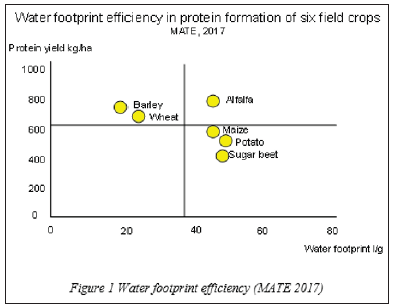- Submissions

Full Text
Environmental Analysis & Ecology Studies
Water Footprint of the Protein Formation of Six of Field Crop Species
Márton JOLÁNKAI, Ákos TARNAWA, Katalin M KASSAI, Adnan ESER and Zoltán KENDE*
Hungarian University of Agriculture and Life Sciences MATE, Hungary
*Corresponding author: Zoltán KENDE, Hungarian University of Agriculture and Life Sciences MATE, Agronomy Institute 2100 Gödöllő Páter Károly utca, Hungary
Submission: March 22, 2021Published: April 27, 2021

ISSN 2578-0336 Volume8 Issue3
Introduction
The availability and the consumption of water is one of the major physiological factors influencing plant growth and development. Water footprint is an indicator that shows the extent of water use in relation to consumption. Water use, consumptive use, and evapotranspiration are terms used interchangeably to describe the water consumed by crop plants Most of water is mainly used for physiological processes, only a negligible amount is retained by the crop for building its tissues. Water requirements for crops depend mainly on species and environmental conditions [1].
Materials and Methods
An agronomic study has been done at the Hungarian University of Agriculture and Life Sciences, Gödöllő to evaluate and identify the water footprint of protein yield of field crop species. Six field crop species (Sugar beet Beta vulgaris, winter barley Hordeum vulgare, winter wheat Triticum Aestivum, Maize Zea Mays, Potato Solanum Tuberosum, and Alfalfa Medicago Sativa) were involved in the study. Evapotranspiration patterns of the crops studied have been identified and physiologically reliable protein ranges within crop yields were evaluated [2].
Result and Discussion
Water footprint of six field crop species (Sugar beet Beta vulgaris, winter barley Hordeum vulgare, winter wheat Triticum aestivum, Maize Zea mays, Potato Solanum tuberosum, and Alfalfa Medicago sativa) were evaluated.
The results obtained in this research are presented in Table 1 suggest, that water footprint of cereals proved to be the lowest, however maize values were highly affected by the high variability of protein yield. Alfalfa, potato, and sugar beet water footprints were in accordance with their evapotranspiration patterns (Figure 1).
Figure 1:Provides information on the magnitude of protein yields of certain field crop species and the amount of water used for its formation.

Table 1:Water footprint of six field crop species (MATE, 2017).

*hay
Conclusion
Physiological characteristics of field crop species highly influenced the magnitude of their water footprint. According to the results of the study protein yield proved to be the most reliable basis for comparison of water footprint performance. Water footprint of cereal crops seems to be much less than that of other field crops. Further studies are needed to clear and obtain more detailed data concerning water footprint of field crops [3].
Acknowledgement
This article presents research results gained from a long-term trial supported by TÁMOP, NVKP and VKSZ funds of the Government of Hungary.
References
- Jolánkai M, Kassai MK, Tarnawa Á (2018) Water footprint of field crop species based on their protein yield. In: Celková A (Ed.), Transport of water, chemicals and energy in the soil-plant-atmosphere system. UH-SAV, Bratislava, Slovakia, pp. 32-36.
- Várallyay G (2008) Extreme soil moisture regime as limiting factor of the plants’ water uptake. Cereal Research Communications 6(Suppl 3): p. 3.
- Wichelns D (2010) Virtual water and water footprints offer limited insight regarding important policy questions. International Journal of Water Resources Development 26(4): 639-651.
© 2021 Zoltán KENDE. This is an open access article distributed under the terms of the Creative Commons Attribution License , which permits unrestricted use, distribution, and build upon your work non-commercially.
 a Creative Commons Attribution 4.0 International License. Based on a work at www.crimsonpublishers.com.
Best viewed in
a Creative Commons Attribution 4.0 International License. Based on a work at www.crimsonpublishers.com.
Best viewed in 







.jpg)






























 Editorial Board Registrations
Editorial Board Registrations Submit your Article
Submit your Article Refer a Friend
Refer a Friend Advertise With Us
Advertise With Us
.jpg)






.jpg)














.bmp)
.jpg)
.png)
.jpg)










.jpg)






.png)

.png)



.png)






